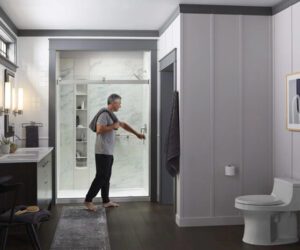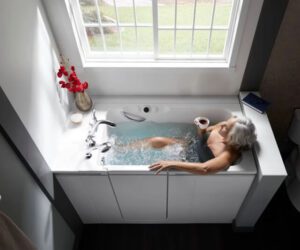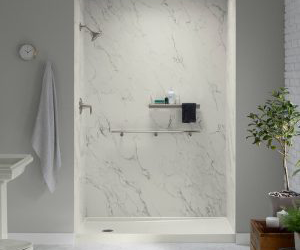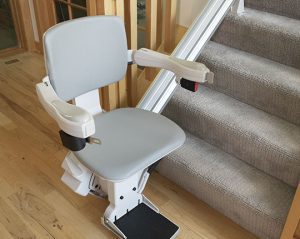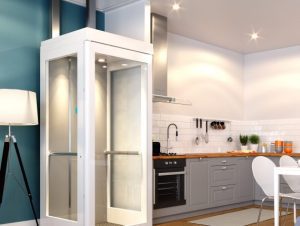Many elderly people find it hard to move around their homes. Stairlifts can change this by making every floor accessible. This blog post will explore how stairlifts offer safety, mobility, and independence for seniors.
Keep reading to learn more about enhancing independence with stairlifts.
The Need for Independence in the Elderly
As aging sets in, maintaining independence becomes a crucial aspect of the elderly’s lives. Mobility challenges and an increased risk of falls can gradually lead to a loss of autonomy for seniors.
Challenges with mobility
Many elderly individuals face challenges with mobility as they age. Moving around the house becomes harder, especially when it involves stairs. This decrease in mobility can make everyday tasks difficult and limit their ability to live independently.
As a result, seniors might avoid certain areas of their home or miss out on activities they once enjoyed.
Stairlifts offer a solution to these accessibility problems by providing a safe way for seniors to navigate between floors without the risk of falling. By addressing agerelated mobility issues with such assistive technology, homeowners can significantly improve the quality of life for their elderly family members.
Ensuring easy access throughout homes helps maintain senior independence and supports active engagement in daily living challenges.
Get Started Today
Straight Stair Lifts installed in days, not weeks
Increased risk of falls
Falls pose a significant threat to seniors’ safety and independence, leading to considerable personal and economic costs. The Centers for Disease Control and Prevention (CDC) highlights that falls are the leading cause of injury among seniors, directly impacting their ability to live independently.
Issues with mobility often contribute to this risk, especially when it involves stairs or steps, making fall prevention a critical concern for elder care.
Senior safety requires attention to eliminating hazards that increase the chance of falls. With aging comes challenges in mobility that make navigating steps perilous. Ensuring environments are adapted to meet these challenges is essential in reducing geriatric injuries and preserving independence in older adults.
Strategies focused on stair safety can significantly mitigate the risk of falling for seniors, helping them maintain their autonomy and quality of life.
Loss of independence
Loss of independence significantly affects the elderly, making daily activities challenging. Older adults often face difficulties with stairs, which can lead to falls and injuries.
This situation not only increases their risk of physical harm but also strips away their confidence and self-sufficiency. The fear of falling prevents many from moving freely within their homes, pushing them towards a reliance on others for help.
Loss of independence can be discouraging to older adults who have spent their entire lives living independently.
Preserving seniors’ ability to live independently is crucial for their well-being. A loss in mobility or the occurrence of a fall should not be the end of their autonomy. Solutions that enhance elderly mobility and safeguard them against injuries are essential in maintaining older adults’ freedom and dignity in old age.
Benefits of Stairlifts for the Elderly
Stairlifts enhance safety, allowing the elderly to move freely and independently throughout their homes while reducing the risk of falls. With increased mobility and ease of access to different levels of their home, stairlifts enable seniors to maintain their independence.
Improved safety
Stairlifts enhance safety by reducing the risk of tripping and falling, providing a secure mode of transportation. They eliminate hazards such as missing steps or slipping, ensuring peace of mind for elderly individuals moving between floors.
The inclusion of seats or safe platforms with handles further supports stability and minimizes the likelihood of accidents.
Stairlifts also promote independence by allowing seniors to move freely around their homes without assistance, decreasing the need for constant supervision. This accessibility equipment offers homeowners an effective solution to address mobility challenges and mitigate potential falls, ultimately contributing to a safer living environment for aging in place.
Increased mobility
Stairlifts empower elderly individuals and those with mobility challenges to move freely around their homes. These devices offer increased independence and accessibility, allowing seniors to navigate staircases without assistance and reducing the risk of falls.
By providing a safe and reliable means of transportation between different levels of the home, stairlifts enable individuals to maintain an active lifestyle while ensuring their safety.
Additionally, they contribute significantly to aging in place, enabling homeowners to stay in their familiar environment without limitations on movement or activities.
The installation of a stairlift not only enhances mobility but also fosters a sense of autonomy for elderly individuals with limited physical capabilities. It allows them to continue living independently within their homes, promoting a higher quality of life as they retain control over their daily activities.
Preservation of independence
When it comes to aging in place, preserving independence is essential. Stairlifts play a crucial role in maintaining seniors’ dignity and quality of life. These mobility aids not only enhance safety on stairs but also empower elderly individuals to regain control over their lives.
By reducing the risk of falls and injuries, stairlifts enable independent living by providing a safe and convenient means of traversing staircases. Furthermore, they promote confidence, continued engagement in social activities, and the pursuit of daily tasks, thus contributing significantly to the preservation of independence for the elderly.
Stairlifts are designed to enhance mobility and independence for seniors by allowing them to navigate through their homes with ease.
Types of Stairlifts
Straight stairlifts provide a practical solution for those with straight staircases, while curved stairlifts are tailored to fit specific curves and angles. Outdoor stairlifts offer the flexibility of safe and secure mobility outdoors.
Read more about the benefits of these options in our article on enhancing independence for the elderly.
Straight stairlifts
Straight stairlifts provide a precise fit to ensure smooth navigation on unique staircases. These lifts are associated with breaking down barriers for the elderly and individuals with disabilities, enhancing independence.
They offer improved safety and increased mobility, allowing users to preserve their freedom while navigating their homes comfortably. Designed as home accessibility solutions, straight stairlifts play a crucial role in providing independent living aids and ensuring home safety for those facing mobility challenges.
Curved stairlifts
Transitioning from straight to curved stairlifts, homeowners may encounter the need for specialized solutions that cater to complex staircase layouts. Curved stairlifts are designed to enhance accessibility on spiral or curved staircases, offering tailored mobility solutions where standard straight models fall short.
These custom stairlifts adapt to the everchanging shapes of stairs, providing flexibility and precision in navigation through intricate staircase configurations. With their unique ability to unlock the secrets of complex staircase accessibility, curved stairlifts stand as robust mobility aids for homeowners seeking more than just a standard solution.
Outdoor stairlifts
Outdoor stairlifts provide a safe and convenient means for the elderly to navigate stairs outside their homes. They offer a practical way to overcome challenges associated with outdoor staircases, such as weakness, balance issues, or joint pain.
These aids empower individuals with mobility limitations to regain control over their lives and maintain a sense of independence. For some seniors, navigating outdoor stairs can become too difficult due to limited mobility, making outdoor stairlifts a valuable addition to their homes.
Additionally, outdoor stairlifts provide a means for individuals with disabilities to maintain their independence and continue living comfortably in their own homes. Stairlift companies have a strong commitment to promoting independence and breaking down barriers, providing customers with outdoor stairlifts that enhance mobility and independence.
Choosing the Right Stairlift
When choosing the right stairlift, assess individual needs. Consider budget and space for installation and maintenance.
Assessing individual needs
Assessing individual needs is crucial when considering a stairlift for the elderly. It involves understanding their specific mobility challenges and requirements to ensure the right fit.
This assessment helps in determining whether a straight, curved, or outdoor stairlift would be most suitable for their home environment while also considering factors such as budget, space availability, and maintenance needs.
By carefully evaluating these individual needs, homeowners can make informed decisions that contribute to improved safety and enhanced independence for their elderly loved ones.
When choosing a stairlift, it’s essential to assess the unique mobility limitations of the elderly person. Understanding their specific needs ensures that the selected stairlift provides optimal support and enhances their ability to navigate stairs safely.
Considering budget and space
When it comes to choosing the right stairlift, homeowners should carefully consider budget and space constraints. Assessing individual needs is crucial in ensuring that the chosen stairlift meets specific requirements while also taking into account financial considerations and available space within the home.
Comparing pricing, features, and options is important when selecting a suitable stairlift for elderly individuals or those with disabilities. Budget and space constraints underpin the need for a tailored approach to finding a residential stairlift that not only enhances mobility but also fits seamlessly into the home environment.
It’s advisable to meticulously assess both budget and space constraints before embarking on the selection of a residential stairlift. By doing so, homeowners can unlock accessibility options while keeping costs within their means.
Installation and maintenance
Stairlifts should be installed by professionals to ensure safety and effectiveness. Regular maintenance is crucial to keep the stair lift in good working order and prevent unexpected breakdowns. Here are important factors to consider for installation and maintenance:
- Professional Installation: Proper installation by experienced technicians ensures the stairlift functions safely and reliably.
- Regular Maintenance: Scheduled servicing is vital to maintain the safety features and efficient operation of the stair lift.
- Service Plans: Many installers offer service plans, facilitating regular maintenance visits to uphold the reliability of the stair lift.
- Safety Checks: Periodic safety inspections are essential to identify and rectify any potential issues with the stair lift.
- Emergency Repairs: Swift access to repair services is critical in case of any unexpected malfunctions.
Contact Caliber Home Solutions
By installing a stairlift, seniors can regain independence and move around their home with ease. This practical solution enhances safety and reduces the risk of falls. Furthermore, it allows older adults to access upper levels independently.
Implementing these mobility solutions not only improves elderly individuals’ quality of life but also emphasizes the importance of aging in place. Contact Caliber Home Solutions today to learn how we can help!
FAQs
1. How do stairlifts benefit the elderly?
Stairlifts provide a safe and convenient way for the elderly to move between different levels of their home without the need for strenuous physical effort.
2. Are stairlifts easy to operate for the elderly?
Yes, modern stairlifts are designed with user-friendly controls and safety features that make them easy and intuitive for the elderly to use.
3. Do I need to modify my staircase to install a stairlift?
No, most stairlifts are designed to be installed on standard straight or curved staircases without requiring major modifications to the existing structure.
4. Can a caregiver assist in operating a stairlift if needed?
Yes, caregivers can help ensure that the elderly person safely boards and operates the stairlift when necessary.
5. How much does it cost to install a stairlift in a home?
The cost of installing a stairlift varies based on factors such as the type of staircase, additional features, and any customization required. It’s best to consult with an experienced provider for an accurate quote.

